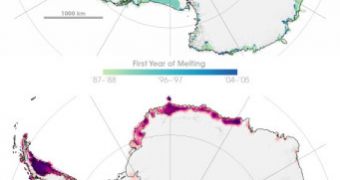A new international expedition is to analyze the vast lands of the Larsen C ice shelf, a chunk of ice about the size of Scotland. This is all that remained from a much larger spread of ice, which melted successively – Larsen A in 1995 and Larsen B in 2002. The main goal of this expedition is to find out if the remaining ice, which holds back a huge glacier that drains a significant part of the Antarctic, poses any immediate danger of melting over the next years or decades.
Ironically, if Larsen C melts, it will not affect sea levels at all, because the ice is already floating on top of the ocean. But if it goes down, two things will happen. First, the dead water effect will increase around the southern tip of South America, and, secondly, the huge glaciers that the ice shelf holds back will accelerate towards the ocean. When they are completely melted and into the waters of the ocean, they will cause a 20-30 cm (8-12 inches) sea level rise worldwide. Needles to say, most dams and other defenses large cities such as London, New Orleans, Rotterdam, Tokyo and New York have against floods could be entirely overwhelmed.
Basically, right now the Antarctic resembles a full bucket in most aspects. The ice shelves are the walls of the bucket that keep the fresh water of the glaciers inside. If the walls break, its location, at the South Pole, will allow it to communicate with three oceans and instantly raise their levels significantly. It doesn't take several feet of ocean level rise to flood major urban areas throughout the globe.
The U.N. estimates that by the end of this century, the waters will have risen worldwide by up to half a meter, meaning that all port cities are in danger of having their dams break or simply covered in water. Predictions show that Manhattan will be entirely covered in water if the rise occurs. To prevent such situations, the international team took it upon themselves to use drilling and sonar in an attempt to determine exactly for how long the Larsen C shelf will remain attached to the Antarctic.
Their studies will reveal whether the separation will occur next year or over two decades. Until then, a more pressing concern is to determine if global warming is responsible for this phenomenon, or if local warming is to blame.

 14 DAY TRIAL //
14 DAY TRIAL //